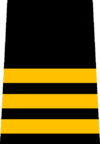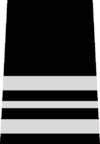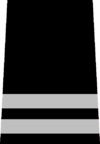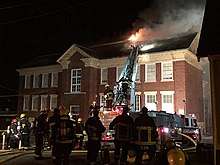Vancouver Fire and Rescue Services
Vancouver Fire Rescue Services (VFRS) was founded in 1886 and today serves the city of Vancouver, British Columbia providing fire, medical first response, rescue and extrication services. In 2017, VF&RS responded to 67,000 emergency calls.[1]

| People Who Care About You | |
| Agency overview | |
|---|---|
| Established | 1886 |
| Employees | 800 |
| Staffing | Career |
| Fire chief | Darrell Reid (2017) |
| EMS level | First Responder |
| Facilities and equipment | |
| Stations | 20 |
| Engines | 21(17 engines/4 rescue engines) |
| Trucks | 9 |
| Platforms | 1 |
| Ladders | 9 |
| HAZMAT | 1 |
| USAR | 1 |
| Wildland | 3 |
| Fireboats | 2 |
| Light and air | 1 |
| Website | |
| VFRS | |
History
The Vancouver Volunteer Fire Brigade was established in 1886 with one volunteer hose-wagon company assigned to protect the new city which mainly had lumber mills at the time, and within 16 days of its existence, the city of Vancouver burned to the ground.[2] A week after the fire the city purchased its first fire engine from Ontario, the item arrived in August of that year, which made the volunteers confident that they could handle any situation that occurred. A second engine arrived in 1888 along with two new firehalls growing the strength from one company to three companies. J.H. Charlisle was appointed the city's first fire chief who began motorizing fire brigade...the first motorized fire engine was purchased in 1908 from the Seagrave company of Columbus. By 1911, the department was ranked third best in the world, falling behind London and Leipzing Germany. By 1917 it was completely motorized (no more horse-drawn equipment) and was then recognized as the Vancouver Fire Department.[2][3] In 1929 the municipalities of South Vancouver and Point Grey amalgamated with the City of Vancouver which also meant the merger of the South Vancouver Fire Department and the Point Grey Fire Brigade, which added six new halls and increased the strength of the department by 100 men.
Since 1893, 48 Vancouver firefighters have died in the line of duty.[4]
Operations
Rank Structure
| Rank | Fire Chief | Deputy Fire Chief | Assistant Chief | Battalion Chief | Training Officer | Captain | Lieutenant | Firefighter | Probationary Firefighter |
|---|---|---|---|---|---|---|---|---|---|
| Rank Epaulettes |  |
 |
 |
 |
 |
 |
 |
No Insignia | No Insignia |
| Rank Pins | .png) |
.png) |
.png) |
.png) |
.png) |
.png) |
.png) |
No Insignia | No Insignia |
| Helmet colour | White | White | White | White | Red | Red | Red | Yellow | Yellow |
| Description | Chief of Department and General Manager | Second-in-command to Fire Chief | Chief of Operations | Command officer in charge for 1 Battalion | Training Officer in charge of Firefighter education and departmental education | Command officer in charge of 1 Fire Hall and Company officer for 1 Engine/Rescue Engine | Company officer in charge of 1 Ladder or secondary Engine (Pump) | Firefighter role is to maintain and master personal firefighting and EMS skills | Probationary Firefighter role is to learn how to execute the duties of a firefighter while being mentored by senior firefighters and officers |
Current Fire Chief and General Manager - Darrell Reid
Fire Hall Locations and Apparatus
There are currently 20 Fire Halls located throughout the city of Vancouver, organized into three Battalions.
| Firehall Numbers | Neighbourhoods | Engines / Pumps & Rescue Engines | Ladders & Towers | Medics & Wildlands | Battalion Chiefs | Special units | Addresses | Opening Dates |
|---|---|---|---|---|---|---|---|---|
| 1 | Strathcona | Engine 1 | Ladder 1 | Medic 1 | Battalion Chief 1 | Car 73 (Fire Investigator), Pod 1, Logistics unit, Community Services, Mechanic 1, Mechanic 2 | 900 Heatley Avenue | 8/8/75 |
| 2 | Downtown Eastside | Engine 2 | Ladder 2 | Medic 2, Medic 23 | 199 Main Street | 8/8/75 | ||
| 3 | Mount Pleasant | Engine 3 | Ladder 3 | Medic 3 | 2801 Quebec Street | 1/27/01 | ||
| 4 | Fairview | Rescue Engine 4 | Medic 4 | Command 4 | 1475 West 10th Avenue | 5/11/92 | ||
| 5 | Killarney | Engine 5 | 3090 Rosemont Drive (Temporary Hall) | 5/13/15 | ||||
| 6 | West End | Engine 6, Pump 6 | 1001 Nicola Street | 3/01/1908 (renovated in 1989) | ||||
| 7 | Downtown | Rescue Engine 7 | Ladder 7 | Wildlands 7 | 1090 Haro Street | 12/5/74 | ||
| 8 | Yaletown | Engine 8 | Ladder 8 | Medic 8 | 895 Hamilton Street | 12/5/74 | ||
| 9 | Grandview-Woodland | Engine 9 | Medic 9 | Tech Rescue 9 | 1805 Victoria Drive | 2/12/60 | ||
| 10 | University Endowment Lands | Engine 10 | Tower 10 | Wildlands 10 | Parade | 2992 Wesbrook Mall | 1982 | |
| 12 | Kitsilano | Engine 12 | Medic 12 (Marine Support Unit) | Hose Tender | 2460 Balaclava Street | 7/11/87 | ||
| 13 | Riley Park | Engine 13 | Air & Light 13, Rehab Support 13 | 4013 Prince Albert Street | 4/4/03 | |||
| 14 | Hastings-Sunrise | Engine 14 | 2804 Venables Street | 8/13/79 | ||||
| 15 | Renfrew-Collingwood | Rescue Engine 15 | Ladder 15 | Medic 15 | Battalion Chief 2 | 3003 East 22nd Avenue | 3/26/12 | |
| 17 | Victoria-Fraserview | Rescue Engine 17 | Ladder 17 | 1443 East 55th Avenue (Temporary Hall) | 8/16/18 | |||
| 18 | Shaughnessy | Engine 18 | Ladder 18 | Medic 18 | Battalion Chief 3 | Hazmat 18, Hazmat Tender 18, Mask Repair unit | 1375 West 38th Avenue | 7/22/00 |
| 19 | West Point Grey | Engine 19 | 4396 West 12th Avenue | 7/3/80 | ||||
| 20 | Kensington-Cedar Cottage | Engine 20 | Antique | 5402 Victoria Drive | 11/9/62 | |||
| 21 | Kerrisdale | Engine 21 | 5425 Carnarvon Street | 6/7/85 | ||||
| 22 | Marpole-Oakridge | Engine 22 | Ladder 22 | Wildlands 22 | Hazmat Tender 22 | 1005 West 59th Avenue | 6/18/82 | |
| Training Facility | Strathcona | Special Operations unit, HUSAR Support unit, Logistics unit | 1330 Chess Street | |||||
| Marine Unit | Fireboat 1, Fireboat 2, Fireboat 5 | Various locations | ||||||
| Reserve Apparatus | Engines (x5), Rescue Engine (x1) | Ladders (x3) |
Vancouver's current complement of fire apparatus includes:
- 13x 2007 Spartan / Smeal CAFS engines
- 2x 2007 Spartan / Smeal CAFS 125' aerial ladder quints
- 2x 2007 Spartan / SVI custom-built hazmat units (1 unit later converted to command unit)
- 1x 2007 Spartan / SVI air/light equipment unit
- 14x 2016/17 Spartan / Smeal CAFS engines/rescue-engines
- 10x 2016/17 Spartan / Smeal CAFS 105' aerial ladder quints
- 1x 2016 Spartan / SVI technical heavy rescue
Fire Boats

The VFRS has operated fireboats since 1928 when the city introduced the J.H. Carlisle. It currently operates 3 boats, Fireboats 1 and 2 are Firestorm 40s, built by MetalCraft Marine in Kingston Ontario. These boats went into service in 2016 and 2017.Fireboat 4 was part of a fleet of five aluminum boats designed by naval engineering firm Robert Allan Ltd. and built in 1992 and has been retained as a reserve vessel.
Former fireboats:
- J.H. Carlisle 1928-1971
- Fireboat No. 2 1951-1987
Crest
VFRS uses a standard logo displayed on uniforms and vehicles:
- Maltese cross
- fire hydrant
- EMS Star of Life
- helmet, ladder, horn, hook and axe
Response
Tap Out Response Medical Aids
| Call Type | Number Of Rigs Needed |
|---|---|
| General | 1 Apparatus |
| Cardiac Arrest | 1 Apparatus
(2 for full Cardiac Arrest) |
| Stroke | 1 Apparatus |
| Stabbing | 1 Apparatus |
| Shooting | 1 Apparatus |
| Mass Casualty Incident
(5 or More Patients) |
2 Apparatus and Battalion Chief |

Tap Out Response Non Medicals
| Call Type | Number Of Rigs |
|---|---|
| Motor Vehicle Incident | 1 Apparatus with Pumping Capability |
| Motor Vehicle Incident
Multiple Patients |
1 Rescue Engine or Engine Capability and
1 Medic Or 1 Rescue |
| Motor Vehicle Rollover | 1 Rescue Engine and Battalion Chief or
1 Medic |
| General Fire Alarm (Low Risk) | 1 Apparatus with Pumping Capability |
| General Fire Alarm (Moderate Risk) | 1 Apparatus with Pumping Capability and
1 Ladder |
| General Fire Alarm (High Risk) or
Reported Structure Fire |
4 Apparatus with Pumping Capability and
1 Medic / Rescue Unit and 1 Battalion Chief |
| Rubbish Fire | 1 Apparatus with Pumping Capability |
| Vehicle Fire | 1 Apparatus with Pumping Capability |
| Vehicle Fire
Alternative Fuel |
2 Apparatus with Pumping Capability |
| Wildland Fire Smoldering | 1 Apparatus with Pumping Capability |
| Wildland Fire Small Area | 1 Apparatus with Pumping Capability and
1 Wildland Vehicle |
| Wildland Fire Large Area | 2 Apparatus with Pumping Capability and
1 Wildland Vehicle |

Structure Fire Response
| Alarm | Apparatus |
|---|---|
| 1st Alarm Assignment | 4 Apparatus with Pumping Capability and
1 Medic / Rescue Unit and 1 Battalion Chief |
| Working Fire Assignment | 1 Rescue Engine (RIT) and
1 Air Light Unit and 1 Rehab Support Unit and 1 Fire Investigator and 1 Additional Battalion Chief |
| 2nd Alarm Assignment | 2 Apparatus with Pumping Capability |
| 3rd Alarm Assignment | 2 additional Fire Apparatus
1 Command Vehicle (Optional) Staff Battalion Other Apparatus as requested |
| 4th Alarm Assignment
(After Deputy Chief Approval) |
Additional Apparatus as requested |
| 5th Alarm Assignment | Additional Apparatus as requested |
| 6th Alarm Assignment | Additional Apparatus as requested |
| 7th Alarm Assignment | Additional Apparatus as requested |
| 8th Alarm Assignment | Additional Apparatus as requested |
| 9th Alarm Assignment | May Involve Mutual Aid |
| 10th Alarm Assignment | May Involve Mutual Aid |
Call Volume
| Fire Hall | Location | Number Of Calls | Busiest Apparatus |
|---|---|---|---|
| Fire Hall 2 | Downtown Eastside | 1200+ per month | Medic 23 |
| Fire Hall 7 | Downtown | 500+ per month | Rescue Engine 7 |
| Fire Hall 8 | Yaletown | 500+ per month | Medic 8 |
Call Volume
| Year | Overall | Busiest Unit | Top Call |
|---|---|---|---|
| 2013 | 30,000 | Engine 7 | Medical Aid |
| 2014 | 38,000 | Engine 2 | Medical Aid |
| 2015 | 44,000 | Medic 2 | Medical Aid |
Major incidents and disasters
Great Vancouver Fire
On June 13, 1886, workers were burning brush to make way for development when high winds picked up the flames and began burning out of control. Vancouver Volunteer Hosewagon Company No. 1, comprising a dozen volunteers, grabbed buckets and axes in attempt to extinguish the conflagration. The city had purchased a fire engine which had not yet arrived resulting in most of the city being burned down in 45 minutes.
BC Forest Products
On July 3, 1960, a fire broke out at the BC Forest Products Mill near Oak St and W 6th Ave. Initial crews responded and reported large flames and smoke coming from the mill. The chief on scene quickly upgraded the alarm calling in additional companies. Flames started to spread quickly from the mill itself to a nearby dock, which resulted in the Chief declaring the incident as a five alarm call, VFRS's first five-alarm fire. All halls were tapped out which sent the fire boat and all but a few apparatus down to the fire ground. A total of 350 firefighters battled the flames for hours on the hot day. A large crowd had gathered to watch firefighting operations which hampered efforts to extinguish the blaze. Most of the mill burned before the fire was extinguished.
Stanley Cup Riot (2011)
On June 15, 2011, the Vancouver Canucks were in the final game of the Stanley Cup playoffs. Over 100,000 people had gathered in the Downtown core to watch the game on large outdoor screens. Around 8 PM the game was nearing the end with Canucks losing by several points, and at that moment the crowd started to become unruly. Families decided to leave before the game was over and headed out of the Downtown core. Police officers staged near the CBC live site at Georgia and Cambie moved into a large crowd of fans when they started throwing objects at the large screen. The crowd at the CBC live site preceded to flip over a pickup truck outside the Canada Post building and light it ablaze. Police offices formed a circle around the burning truck and cleared a path for Engine 8 to bring in a Supply line and crew. Engine 8's crew were able to knock down the fire, but were forced to leave the area as the crowd started throwing objects at police officers. The Emergency Operations Center was activated and Police teams were sent to various intersections to form up and don riot gear. Multiple fire apparatus were sent to key locations and were told to stage and remain visible in case people required medical treatment or had information to report. Around 8:30 violence spilled into other areas of the Downtown core resulting in fights, rubbish fires and burning vehicles. Fire crews were unable to reach some of the injured as violent crowds continued with destruction and mayhem. Orders were given at 9 pm for all staged apparatus to return to quarters and wait for further instructions due to the fact at the time Vancouver Police was deploying crowd control officers armed with tear gas and flash grenades. Dozens of 911 calls were being made from within the Downtown core reporting various incidents such as fires and medicals ; however, these incidents could not be confirmed without an apparatus being dispatched to the scene. Crews were sent to investigate the incidents while remaining in constant communication with the Emergency Operations Center. At around 10 pm a call came in reporting a fire inside a parking structure at Seymour and W Georgia, which sent a full alarm assignment including Ladder 7 who had just wrapped up an investigation of a possible person that had been severely beaten. Ladder 7 reported Georgia Street being as being completely impassible and informed dispatch that any crews responding to an incident on that street would have to walk into that crowd. Upon arrival at the parking structure Engine 7 found a fully involved vehicle on fire with several other vehicles burning. Battalion 1 went inside the parking structure and found people on the roof and determined that they were not willing to come down. Dispatch advised crews that a police line was headed in their direction to control the violent crowd outside the parking structure. Reports were later coming in of 2 vehicles burning on Granville Street in front of The Hudson's Bay, which was confirmed by a police helicopter. Engine 7 and Quint 6 were sent into the area but there was nothing that could be done as people were jumping through the flames and were smashing store front windows. Vancouver Police sent a Tactical Squad to the location of the fire and quickly cleared the street using tear gas and rubber bullets, which allowed fire crews to knock the fire down which was close to setting the building alight. It took only 3 hours for police and emergency personal to bring the situation under control and a full review of the incident was conducted by the provincial government.
Granville Seniors Center

Calls started coming in around 18:50 on October 3, 2014 about a fire at a construction site on Granville Street and 49th Avenue in Vancouver. Initial units that were dispatched were able to see the large column of thick black smoke that was visible all around the Lower Mainland. Vancouver Battalion Chief 3 made it a working fire before any crews arrived on scene. Once crews arrived on scene they reported a large working structure fire of a four or five story complex under construction. Fire had originated in the top floor and was spreading quickly. Before crews arrived it had engulfed most of the roof and was spreading to the sides quickly. On arrival of Battalion Chief 3, he immediately made it a 3rd Alarm Fire as large numbers of crews were required to knock the fire down and prevent exposure of nearby buildings. Granville Street was quickly shutdown, creating major traffic problems and the Vancouver Police Department were called in for traffic control. British Columbia Ambulance Service was also request for standby. The fire was quickly upgraded to a 4th Alarm before crews were able to get the fire under control. Security on site had reported that there may be some propane tanks inside the building for construction use. The roof and sides of the building began to collapse after about an hour and police pushed most spectators back a block or more. Rehab and Command was set up at Granville Street & 49th Avenue. Staging was also set up on Granville Street & 49th Avenue on 49th Avenue on the North side. A firefighter required medical treatment after the majority of the fire was knocked down and no other injuries were reported. The trolley cables for the electric buses were shut down on Granville Street due to the proximity of the fire. Crews remained on scene during the night and all day on Saturday October 4. In the late morning of October 4, 2014, Granville Street had to be closed to traffic for more than an hour after a large flare up required several units to be brought in to help fight the flare up.
Port Metro Vancouver Fire
On March 4, 2015, a security guard at the Port of Vancouver noticed smoke coming from a shipping container. He immediately notified E-Comm 911 which in turn activated a report of a smoke call. Battalion 1 was placed in charge of the scene and upon arrival, declared the incident a structural fire for thick white smoke could be seen emerging from the container. A working alarm assignment was declared immediately followed by a 2nd alarm which included response from Hazmat 18, Vancouver Police, and BC Ambulance Service. Hazmat 18 crew identified the burning content as trichloroisocyanuric acid, a dangerous chemical. Command immediately declared the event as a 3rd alarm and additional police units were called in to evacuate the zone. Warnings were issued to people living in the vicinity to stay at home and lock their doors and windows to prevent gas from entering. At around 3 pm, a 4th alarm was declared and Command 4 was dispatched to the scene along with assistant chiefs. Command 4 requested fireboats 3 and 5 attend the scene. Fire boats worked from the water side to extinguish the fire while firefighters attacked the flames from aerial ladders. Crews remained on scene for several days trying to put out hot spots.
Carleton School Fire

On August 19th, 2016, Vancouver Fire Dispatch received a complaint of possible smoke in the area of Kingsway and Joyce. Dispatch tapped out Engine 5, Engine 15, Quint 15, Quint 20, Medic 9 and Battalion 2 to the scene. While crews were en route to the call, dispatch received multiple calls from area residents and passersby about smoke billowing out of the roof of Carleton Elementary School. The call was quickly upgraded to structure fire and all crews responding were notified of the development. Upon arrival Engine 5 assumed command of the scene and, confirmed reports of smoke coming from the roof. Engine 5 radioed for Quint 20 to lay line at the rear of the structure, and requested all other apparatus to remain at level 1 staging. Quint 20 laid a 1/4 inch hoseline into the building and preceded to the 3rd floor where heavy fire was present. Command requested a working fire assignment and ordered all other rigs to lay lines accordingly. Before Quint 20 could contain the situation, the flames had already spread into the attic and upper cock loft area, which led to command requesting a 2nd alarm assignment. Quint 20's crew was able to clear fire from the main fire floor and proceed into the attic space however, the attic was quite tight due to the structure being around for over 100 years. A 3rd alarm assignment was called in for manpower as crews cleared the building quickly to resupply on breathing apparatus which ran low. Ladder 17 setup on Mckinnon st, and made an effort to assault the fire from the side of the structure which seemed to have only a small impact on the fire. Crews were unable to assault the fire from above as crews were directly underneath in the attic with hose lines. Command upgraded the call to a 4th Alarm as additional manpower was needed. Three firefighters had to be taken to hospital, as two members suffered smoke inhalation and one member strained his back. The fire was contained several hours later and crews remained on scene to investigate. The fire investigator revealed that someone had broken into the school, and had poured an accelerant near the door to the third floor.
Training Facility
The Vancouver Fire Rescue Services training facility (also known as the Chess Street training grounds) has a burn building and several classrooms. There is also a base for the CAN-TF1 HUSAR (Canada Task Force 1 Heavy Urban Search And Rescue Team), the only HUSAR team in Canada that can be deployed anywhere in the world. The training facility also hosts the department's youth academy outreach program, a week long firefighting academy for senior high school students. BC first responders level 3 and the first aid course required by firefighters is also taught at this facility.
Band
.jpg)
The Vancouver Fire and Rescue Services Band is a community out reach program for the VF&RS. It represents the service as the official police band of the City of Vancouver and Metro Vancouver. It was founded in 1927 and is the longest-serving fire department band in North America. The band is composed of active-duty and retired firefighters, as well as some independent civilians.[5]
The Band performs at a range of events including:
- Ceremonies
- Remembrance Day Services
- Civil Parades
- Medal Presentation Ceremonies
Kris Covlin, a professional saxophonist and former member of the Band of the Ceremonial Guard from 1998-2005, is currently the director of the band.[6]
See also
- E-Comm, 9-1-1 call and dispatch centre for Southwestern BC
- Vancouver Police Department
- British Columbia Ambulance Service
References
- Vancouver Fire and Rescue Services | City of Vancouver. Vancouver.ca. Retrieved on 2014-04-12.
- "History of Vancouver - Vancouver Fire and Rescue: Early Days". Vancouverhistory.ca. 2004. Retrieved 2010-11-25.
- http://www.vffhs.com/history/
- "In The Line Of Duty". IAFF 18. 2010. Retrieved 2010-11-25.
- https://firefightersband.com/about/
- http://royalcityconcertband.ca/